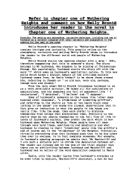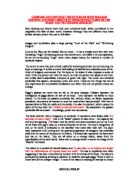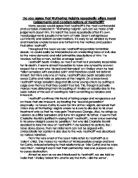How Has Emily Bronte Captured Your Interest?
HOW HAS EMILY BRONTE CAPTURED YOUR INTEREST? Emily Bronte has managed to capture the interest of her readers since her book Wuthering Heights was written in. She has achieved this in a number of ways, i.e. in the way she has portrayed the characters throughout her novel, and in the way that they develop; the way the story is told - i.e. by Nellie and Lockwood; the passionate emotions portrayed by the characters; and also the natural description - the setting, the sense of wildness and the supernatural, and the images and symbolism that are derived from these. By reading her novel, readers can learn a substantial amount about the characters involved. This is in the way she creates a first impression of them to the reader, and then allows them to develop "right in front of their very eyes". Cathy is one of the leading characters in the novel. The first impressions the reader gets of Cathy when she was young was that she was a naughty, mischievous child who was very bubbly, outgoing, and loud. Although she was naughty she was portrayed by Bronte as an angelic figure: "She had the sweetest smile and the bonniest eye". She often aggravated and provoked her father, and was both bold and defying. However she did have a good heart. "Why canst thou always be a good lass, Cathy? And she turned her face up to his, and laughed, and answered, "Why cannot you always be a good man,
Both Wuthering Heights and Catcher in the Rye use very distinctive and individual characters to narrate the stories. What are the characteristics of these narrative voices, and what do they contribute to the novels?
Both Wuthering Heights and Catcher in the Rye use very distinctive and individual characters to narrate the stories. What are the characteristics of these narrative voices, and what do they contribute to the novels? Emily Brontë wrote Wuthering Heights, and was born on July 30th, 1818, and was the fifth child to her mother and father. Her older sisters Maria and Elizabeth both died of tuberculosis in 1825, which was the disease Emily herself also died of, many years later. Frequently, Emily was encouraged to work, or learn away from home, but on all occasions she became ill, and was forced to return home. The exact dates during which Wuthering Heights was written is unknown although it was supposedly written during 1845 - 1846. The Brontë sisters originally had to have their published names changed to male names so the public would buy their books. Women writers were unheard of at this stage in time. Here is a short summary of the story of Wuthering Heights. The story is told by Mr. Lockwood who is the owner of Thrushcross Grange, a house in the same area as Wuthering Heights. He learns more about the two families as his stay progresses. The present housekeeper of Wuthering Heights tells him the story: A man names Earnshaw who live in Wuthering Heights went from his house to Liverpool on a business trip. When he was there he saw a boy who he took home and named
Discuss the portrayal of Heathcliff and Hareton Earnshaw in 'WutheringHeights'. Are they products of nature or nurture?
Discuss the portrayal of Heathcliff and Hareton Earnshaw in 'Wuthering Heights'. Are they products of nature or nurture? I am going to look at the nature and nurture of both Hareton Earnshaw and Heathcliff, of Emily Brontë's 'Wuthering Heights', and try to decide whether these two characters are products of their nature or their nurture. A person's nature is the way they are born, their 'raw state of mind', the parts of their character unaffected by outside influence. A person's nurture is the way they are brought up, and they way they are influenced and shaped by society. The Lintons and Earnshaws are part of the Gentry class of Victorian England; they are both landowning families, fairly high up in the class hierarchy. But the genetic natures of the families are entirely different: the Lintons are well behaved, subdued, spoilt, steady, sensible and arrogant; in comparison, the Earnshaws are strong willed, moody, generous, free spirited, easily influenced, laid back and non-formal. The nurture of the characters is connected very strongly to social status: Heathcliff is denied social status initially by his birth and subsequently by Hindley, which creates great hatred in Heathcliff: this denial of status is perceived much more seriously than what we consider serious today. Catherine chooses Edgar over Heathcliff for reasons of social status, even though she and Heathcliff
Refer to chapter one of Wuthering Heights and comment on how Emily Brontë introduces her reader to the novel in Chapter one of Wuthering Heights.
Refer to chapter one of Wuthering Heights and comment on how Emily Brontë introduces her reader to the novel in Chapter one of Wuthering Heights. Consider: The setting and atmosphere, narrative technique, including the use of Lockwood as a narrator compared with later narrators and preparation in the opening for the rest of the novel Emily Brontë's opening chapter to 'Wuthering Heights' creates intrigue and curiosity. This greatly relies on the atmosphere, narrators and setting Emily Brontë chose to introduce the reader to the different world and people of Wuthering Heights. Emily Brontë starts the opening chapter with a date - 1801, therefore suggesting that this is someone's diary. The diary belongs to Mr Lockwood, who happens to be staying at Thrushcross Grange. Not suprisingly, Lockwood starts his diary off with the word 'I' which sums up Lockwood's egotistical nature. In this new world which makes a distant memory of the civilised society Lockwood comes from, he feels himself to be above those around him, referring to Joseph as ' an old man, very old, perhaps, though hale and sinewy.' From the very onset Emily Brontë introduces Lockwood to us as a very unreliable narrator. He bases all his conclusions on speculations, and his speeches are full of guesswork like ' I conjectured', 'I detected', 'I believe' and 'I suppose'. Some of Lockwood's comments on the
Compare and contrast the styles of both Willian Golding and Emily Bronte in their novels Lord of the Flies and Wuthering Heights.
COMPARE AND CONTRAST THE STYLES OF BOTH WILLIAM GOLDING AND EMILY BRONTE IN THEIR NOVELS "LORD OF THE FLIES" AND "WUTHERING HEIGHTS". Both Golding and Bronte have their own individual style, which contributes to the originality and flair of each novel. However although they are different they share similar devices, which they use to full effect. Images and symbolism play a large parting "Lord of the Flies" and "Wuthering Heights". Lord of the Flies can be viewed like an onion - it has a simple story line with ever increasing "rings" of meaning around that central core. As a fable it is uncomplicated, but as the surrounding "rings" cover many deeper issues, for instance a number of symbolic objects. The conch is more than just a shell, useful for attracting attention and summoning the boys to meetings. It is like a church bell calling the faithful and embodies some of the ritual of religious ceremonies. For the boys on the island it also imposes a sense of order. Only one person can hold the conch, so only one person can speak at one time, and unlike Jack's assemblies, everyone is given that right. The conch can therefore symbolise free speech, democracy, order and unity. These are the things that are of key importance for a successful civilisation, and when they are not present chaos can emerge. Piggy's glasses are more than an aid to his poor eyesight. Glasses represent
The opening three chapters of Wuthering Heights are very similar to chapters 5, 6 and 7 of The Woman in Black.
Wide reading Coursework: Wuthering Heights and The Woman in Black: The opening three chapters of Wuthering Heights are very similar to chapters 5, 6 and 7 of The Woman in Black. In Wuthering Heights, there is an outsider - Mr. Lockwood - who goes to visit Wuthering Heights. Similarly, in The Woman in Black, there is Arthur Kipps, also an outsider of the evil and supernatural in Crythin Gifford, who goes to visit Eel Marshouse. The fact that they are both city dwellers, unfamiliar with the remote and desolate regions that they find themselves in, is very important to both the stories. This is because it makes them both more vulnerable to danger and evil, and it creates a chilling atmosphere for the reader, who, in turn, is an outsider. Moreover, this makes us, the readers, empathize with Kipps and Lockwood, because while reading the stories, we sense in a way the same fear and anxiety that they do, mainly because we too are not familiar with the supernatural. Also, the fact that Kipps and Lockwood are outsiders makes them naïve and less able to handle the situation that they find themselves in. This is essential to both stories, because it helps create an engaging atmosphere, and again empathy for both characters. Chapter 5 of The Woman in Black opens with the words "No car appeared," and we soon learn than a "shabby pony and trap" appeared instead. This means that there
Trace the theme of madness and supernatural in Emily Bront->'s "Wuthering Heights".
Trace the theme of madness and supernatural in Emily Bront?'s "Wuthering Heights". Set in the desolate Yorkshire moors, "Wuthering Heights" is the story of Catherine and Heathcliff. It is a story of passion and violence, a story of madness and supernatural. It starts off when a Victorian gentleman by the name of Lockwood wants to rent the house called Thrushcross Grange. He goes to his landlord's home a few miles away. Ancient and unwelcoming, the house is a perfect reflection of Heathcliff, the landlord. Unperturbed by the unfriendliness of the inhabitants, Lockwood proceeds to rent Thrushcross Grange. Later, during the harsh winter of the moors, Lockwood falls ill and while he is recuperating, he asks his housekeeper, Nelly, to tell him about Heathcliff and explain the strange behaviour of the inhabitants of Wuthering Heights. While Nelly tells her tales, Lockwood writes them in his diary. These writings form the main basis of "Wuthering Heights". Nelly starts the story with her childhood, where she was a servant at Wuthering Heights. At the time, the Earnshaw family lived there. Mr and Mrs Earnshaw and their children Hindley and Catherine. One day, Mr Earnshaw went away and came back with a dark skinned boy who he named Heathcliff. Though she hated him at first, Catherine and Heathcliff soon became best of friends. Hindley, however, is still very cruel to Heathcliff who is
An Assessment of Catherine the Great
An Assessment of Catherine the
Do you agree that Wuthering Heights repeatedly offers moral judgements and condemnations of Heathcliff?
Do you agree that Wuthering Heights repeatedly offers moral judgements and condemnations of Heathcliff? Many people would agree that Heathcliff is the most controversial and complex character in 'Wuthering Heights', yet can we make a fair judgement about him. It is hard if the book repeatedly offers it's own moral judgements (usually in the form of Nelle Dean's self-righteous comments) and blatant condemnations. It is easy to be blinded by these and therefore unable to look any further in to the motives and passion that drive Heathcliff. Throughout the book we see Heathcliff responsible for terrible deeds. He could easily be interpreted as an unrelenting force of evil, due to the many demonic and wild animal-like descriptions of him; 'He howled, not like a man, but like a savage beast.' Heathcliff beats Hindley, so much so that he is probably responsible for his death. It seems almost impossible to have any sympathy or even respect for a man who 'kicked and trampled' on Hindley when he had 'fallen senseless with excessive pain' and therefore could not defend himself. But this is only one of many, Heathcliff also beats Isabella and keeps Cathy and Nelle as prisoners at the Heights. On a lesser level, Heathcliff hangs Isabella's dog and kills some young chicks by putting a cage over them so that they couldn't be fed. This, though is actually maybe more disturbing than his
Compare the Presentation of the Characters of Rochesterin "Jane Eyre" and Heathcliff in "WutheringHeights".
Compare the Presentation of the Characters of Rochester in "Jane Eyre" and Heathcliff in "Wuthering Heights" In the Gothic romances written by the Brontë sisters, there are two fascinating characters with many facets to their personalities. The depiction of Rochester has been done using an autobiographical approach by Charlotte Brontë in "Jane Eyre" and Emily Brontë used dual narration to portray Heathcliff's complexity in "Wuthering Heights". In this essay I am going to investigate the similarities and differences between the characters of Rochester and Heathcliff and how these two Byronic heroes are portrayed by the sisters using language and literary devices. The Byronic hero is a character that has evolved from Lord Byron's writing which influenced the Brontë sisters' work. He appealed to many young girls of that era and his character exhibits moodiness and passion and "emotional and intellectual capacities superior to the average man". The Byronic hero is always the protagonist and he is often a figure of repulsion, as well as fascination due to his rejection of society's moral codes and is deemed to be unrepentant. His superior traits cause him to become arrogant, confident and abnormally sensitive. He is also usually isolated from society, and in these two cases, it is self imposed. "Wuthering Heights" is a classic novel, in which two childhood lovers (Catherine











